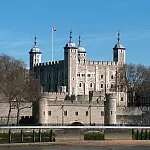The Tale of the Hanbury Hall Ghost of Lost LoveHanbury Hall is a large 18th-century stately home in parkland at Hanbury, Worcestershire and is said to be haunted by spirit of Emma Vernon.
In 1580 the Reverend Richard Vernon (1549 - 1628) arrived in the village of Hanbury to take up his post as local vicar.
Over the following fifty years he and his family would acquire land within the area and by 1630 his eldest son, Edward, had purchased the manor house and the Vernons started an affiliation with Hanbury Hall that would last until 1962 when the house was taken over by the National Trust.
The man accountable for the existing William and Mary style house, which was finished in 1706, was the immensely wealthy legal professional Thomas Vernon, Richard's great-grandson.
Emma Vernon (1754 - 1818) spent her formative years at Hanbury Hall. She grew up to become a famed society beauty and her good looks, coupled with the undeniable fact that she was a heiress to the Hanbury estate, made her extraordinarily desirable as a possible wife. It was Henry Cecil, Earl of Exeter in waiting, who married Emma in 1776 and the couple set about remodelling parts of the house to turn it into an appropriate family homestead.

Unfortunately, a mixture of elements blended to make certain that the direction of true love would, in their case, most by no means run smoothly. Firstly, they got into heavy debt. Secondly, even though they had several children none of them survived infancy. As a result, the couple became disappointed with each other and began to grow apart. In 1785, the local vicar, William Burslem, took on a brand new curate by the name of William Sneyd. Soon Sneyd was a regular guest at the Hanbury Hall dinner table at which, unbeknown to her husband, he had caught Emma's eye.
By 1789, the lady of the house and the parish curate had been conducting an illicit liaison, with Emma stealing away from her husband as frequently as she could to spend time along with her lover. The couple were determined to be together and hatched a cunning plan that they hoped would make that conceivable.
On June 12th 1789 the Cecils went to Birmingham on business. Emma had sent word of their destination to Sneyd and, together with her husband away at a meeting, the two lovers met at an inn from which they eloped. Over the next few months, they travelled together as man and wife, staying at a wide range of inns and hotels around the nation.
The crestfallen Henry, not able to endure the idea of remaining at Hanbury Hall, retreated to a farmhouse in Shropshire, where he lodged with one Thomas Goggins and his family, adopting the nom de plume John Jones to keep his true identity and social standing secret from his hosts. But it wasn't long before he had fallen in love with Goggins's beautiful 16-year-old daughter Sarah, often referred to as Sally. On 10th June 1791, he divorced Emma and, in October of that year, he and Sally were married.
The divorce left Emma free to marry Sneyd, which she did that very same year, although their happiness was short-lived, as he died in 1793.
As for Hanbury Hall, following the divorce Cecil refused to allow his wife to return to her cherished house and he sold off all of the contents. It remained empty until his demise in 1804, after which Emma was able to move back in and she lived out the remainder of her days there with her third husband John Philips until her demise in 1818.
The emotional effect of those long-ago events has lingered on at Hanbury Hall and there have been several sightings of Emma's ghost, dressed in black, around the grounds.

She is particularly fond of drifting serenely alongside the path between the house and the church that her living self used to take to enjoy her trysts together with her lover.










